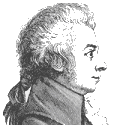Soundtracks:
Elvira Madigan
The Spy Who Loved Me
Amadeus
Regarding Henry





|
Piano Concerto No. 21 in C major K467
 It
is almost unbelievable for a classical piece to remain almost hidden and
forgotten for the repertoire, and then become world-famous practically
over-night, thanks to a motion picture, but this is exactly what happened
to Mozart Piano Concerto in C major. Due to a movie that told the life
story of Swedish trapeze-act star Elvira Madigan, honored by being ornamented
by this music, the concerto became so popular that almost every record
released after that film mentions "Elvira Madigan" as part of
the concerto's title. This is how fame works. It
is almost unbelievable for a classical piece to remain almost hidden and
forgotten for the repertoire, and then become world-famous practically
over-night, thanks to a motion picture, but this is exactly what happened
to Mozart Piano Concerto in C major. Due to a movie that told the life
story of Swedish trapeze-act star Elvira Madigan, honored by being ornamented
by this music, the concerto became so popular that almost every record
released after that film mentions "Elvira Madigan" as part of
the concerto's title. This is how fame works.
This concerto is one of the best C major concertos by Mozart, and indeed
he wrote quite a few. It starts with optimism conflicting with the composer's
previous concerto, written earlier the same year, in amusing and light
sounds. The contrast is so astonishing between the two concertos, composed
only one month apart. The Piano Concerto No. 20 is written in a minor key
(for Mozart, for the first time), and sounds almost like a concerto by
a Romantic composer, whereas Concerto No. 21 is in a major-scale, light
and cheerful.
After the first, fast movement (allegro maestosso), comes the calm Anadante
movement, which is the famous movement of this concerto; the third movement
is a light, humorous rondo.
Piano Concerto No. 21 was performed for the first time on March 12th,
1785, with the composer's father, Leopold Mozart, sitting in the concert
hall, practically in tears, as he himself testifies in a letter to Mozart's
sister. The 30 year-old Mozart, the child-prodigy Leopold nurtured from
a very early age, did not fail. But the sand in Mozart's hour-glass only
had six more years.
|